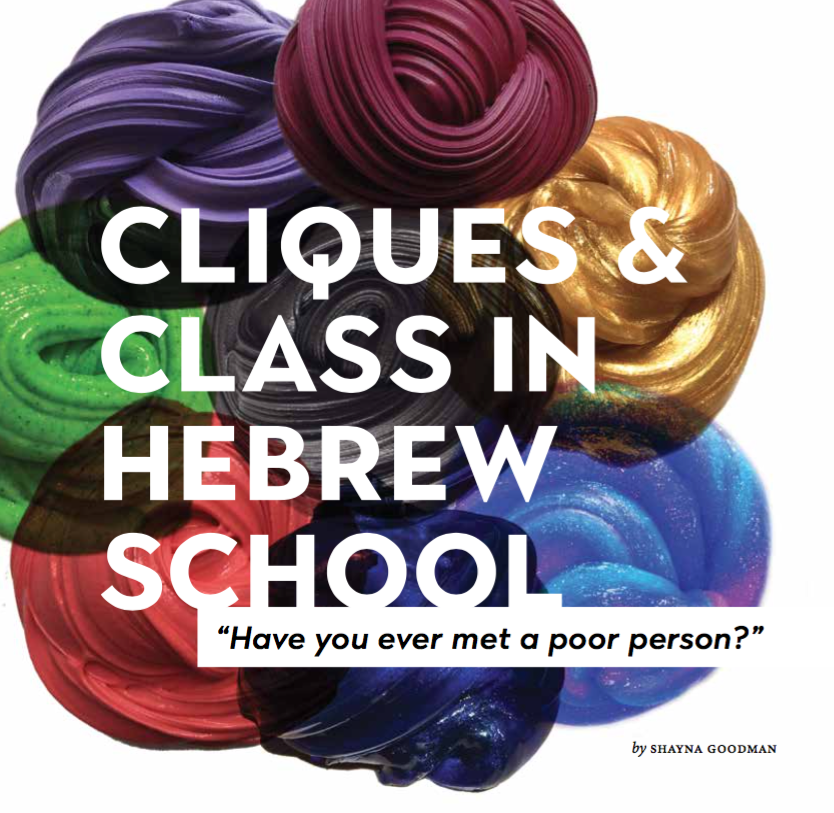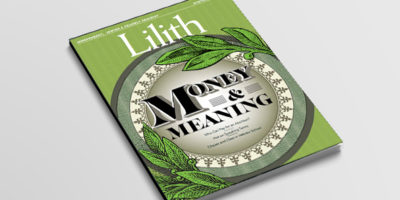
Cliques and Class in Hebrew School
 “Have you ever met a poor person?”
“Have you ever met a poor person?”
IT WAS MY FIRST YEAR TEACHING HEBREW SCHOOL, and I wasn’t especially good at it. Yet the school paid well per hour—maybe too well for the amount of work I put in—and I needed the money, because my salary as an adjunct instructor in the city university system didn’t cover my bills.
The Hebrew school was located in a wealthy synagogue in Manhattan, just a few blocks from the Jewish day schools I had attended on scholarship from 3rd through 12th grade. I was teaching the same subjects I had learned back then: Hebrew, Torah, Jewish history. Teaching Hebrew school brought back an adolescent discomfort: feeling like a charity case in an uptown Manhattan Jewish community. We were not so poor by national standards. Still, my sense of feeling poor was constant when I spent time among peers who, I imagined, did not know about need. My family lived in a 275-square-foot tenement apartment in SoHo where I shared a bedroom with my two siblings. I never had classmates over, because my mother was embarrassed.
Every Thursday afternoon, I reluctantly took the train from my apartment in Brooklyn to teach at the Hebrew school, sweating in my winter coat. Other people move to New York to expand their worlds. I was taking the same subway line I’d relied on in middle school and high school.
At the synagogue, I would watch the kids and their nannies climb the building’s sleek, glass-enclosed staircase up to my fourth grade classroom, which bore the name of a prominent donor. I resented the evident wealth and comfort of the administrative staff; I resented my students and their parents. One of my students, Harper,* had a last name matching a classroom down the hall. She reminded me of the girls I sought approval from in my elementary school: rich, pretty, and domineering. Harper and her two best friends—her disciples—sat together at the U-shaped table, dressed in identical pink shirts with sparkly print that spelled peppy garbage like “#Teamweekend.” For a few weeks, they referred to themselves as “Teamweekend” and the other girls begged to be members of the team. “You have to apply,” Harper said.
Everyone in Teamweekend had gluten allergies and received a special snack: plain Pop Chips. They emptied the Pop Chips on the table and smashed them with water bottles. Then they crunched on the small pieces all through class to make the snack “last longer.”
One student who did not beg to belong to Teamweekend was Ella, who reminded me of myself: a kid on scholarship. Her parents were social workers while mine were struggling artists. She was a weirdo in a pink newsboy cap who read textbooks about ancient Rome under the desk. I had been a weirdo, but a conformist one, studying the other girls so I could dress in poor approximations of their outfits— cheap knock-offs from a store called Kidztown.
On my first day of teaching, Teamweekend said that they had to pee, all at the same time. Uncertain in my new position of authority, I wanted the girls to like me more than I wanted the class to run smoothly.
“Only one at a time,” I said hesitantly.
“Are you new?” Harper asked. I could tell you what she looked like—full cheeks, freckles, long straightened hair—but what matters more is that, at 10 years old, she spoke with a kind of assurance that I imagined came from the combination of looks and financial comfort. “You seem new to me,” she said.
I let them pee at the same time. They returned to class 20 minutes later, giggling. The other students looked at me to see how I would handle this affront to my authority, except Ella, who continued to read about Marcus Aurelius, oblivious to the dynamics around her. After class, I went to Duane Reade and bought a bag of plain Pop Chips.
Hebrew school was just one of many sources of anxiety in my low-income life. My weeks were full of bureaucracy: applying and then reapplying for Medicaid; waiting on line at the billing office at Hunter College to ask why my paycheck was late. But Hebrew school played an outsized role in my emotional life. On Thursday nights, I would pour red wine and tell my boyfriend stories about the bitchy things Harper had said: “Harper called me out for wearing the same jeans two weeks in a row.” Or, “Harper said she liked the substitute teacher better than me because she had a S’well brand water bottle.” Or, “Harper told another girl that when a boy called her fat, it was ‘honestly really funny’.”
I would also talk about Ella: always chewing her hair at her desk, sitting wrong on her chair—sideways on her knees with her butt in the air—writing a fantasy story or drawing another map of the Roman Empire. During group work, the other girls refused to work with her. She’d tell me that she was fine; she wanted to work alone. But I couldn’t watch her, absorbed in another solo project, without my chest tightening. I wondered if she really didn’t care what the others thought of her. “To be honest” (to borrow my students’ favorite construction), I hated her for eliciting such uncomfortable tenderness.
When it was time for bed, my boyfriend would often play a podcast set on a sleep timer. One night, the podcast host’s cheerful voice in the darkness recounted a story about his 10-year-old daughter, who had used his wife’s $65 face cream to make “slime” in her bedroom. Slime, the host explained, was a mixture of different bathroom products that, in the right proportions, became a blob you played with. Tweens and teens across the nation were mixing it and selling it to each other. The slime market was “flooded.” I wondered what slime looked like? What made it so popular? As I drifted out of consciousness, twisted in the sheets, I imagined a liquid green slime, dripping from our bedroom walls.
Towards the end of January, Harper began bringing in slime. She snapped open the lid of a Tupperware container during my lesson, giving hushed orders to the rest of Teamweekend. She divvied up a sparkling gelatinous blob for her friends to play with. “Put it away,” I said, transfixed by the way the girls manipulated the slime, stretching it out and letting it ooze down to the desk. It stuck to their pencils and workbooks. “Just one second,” Harper said.
Harper told the other girls that she had made the slime at her ski house. In the summer, she explained, “I’ll have my own slime room in the Hamptons.” In the following weeks, this was a line I often recounted at parties, unclear if I was appalled or delighted by the image of her alone in a room by the sea, mixing slime. The slime was as trippy and loud and ugly as the Lisa Frank folders that had been status symbols when I was in elementary school. Harper had turned moisturizer, contact lens solution and glue into something exclusive, as only gatekeepers can do.
Growing up, there was never extra money for the small things I wanted, year to year: Tamagotchis, Beanie Babies and, later, Juicy Couture zip-ups. I once begged my mom to buy me Lisa Frank stationery, a folder with golden retriever puppies sticking their heads out of a blue and fuchsia sand castle on a psychedelic beach. Even then I knew that the folder did not match my true taste, which was muted. But it didn’t matter whether or not I liked Lisa Frank. Possessing that ridiculous folder made me feel like a girl who had her own pink and floral bedroom—and health insurance that covered visits to the dentist’s office. I treated the folder like a golden egg, wiping it down with damp tissues in the bathroom when I spilled on it. One day, a girl I admired for having her pulse on the latest trends noted the folder, which I had conspicuously placed on top of my books. “Finally you got something good,” she said. Finally.
As an adult, I hadn’t really moved past that period of aspirational consumerism. I began to read articles about slime on my phone on the subway. I saw a luxury brand of slime advertised on a women’s fashion site—playing with slime, they argued, was a form of self care and stress relief. You could order fancy slime on Etsy in different colors and flavors: unicorn birthday cake, watermelon sangria, lavender milk and orange blossom. Soon, I was following slime-focused Instagram accounts created by tween girls.
“We should have a slime party,” I suggested to my adult friends. “We could drink and just, like, make slime,” I offered. And they agreed, though without my enthusiasm. They didn’t understand that Harper had made it cool.
In February, in a unit on tzedakah, my students acted out hypothetical situations: Your friend does not have enough money to pay for lunch. You have extra money but do not want to embarrass her. What do you do? The student who played the girl with money spoke loudly and cheerfully. “I’ll give you money!” she beamed. Meanwhile, Harper played the poor girl. As part of her performance, she folded into herself, looked down and spoke meekly. “I’m sad and poor,” she whined. She wrapped a sweater like a shmatte around her head and coughed as though sick with tuberculosis. I groaned audibly.
“Harper, have you ever met a poor person?” I asked her. The room was silent. I wanted the students to know that you couldn’t always tell, just by looking at a person, whether or not they were “poor.” Or could you? I wanted to tell her, I am poor, to shock her. I wanted to write it on the white board in the wrong kind of thick, black marker—permanent. But Harper was just a kid; a projection. And I wasn’t going to do anything that would upset the Hebrew school administration. I was hesitant even to ask them questions about my paycheck lest I seem too desperate.
BY SPRING, HARPER WOULD COME IN EACH WEEK with containers labeled according to variety: “butter” slime, “fluffy” slime, “glow in the dark” and “glitter.” She distributed these to select girls in the class: always to Teamweekend, and occasionally to an additional girl of her choice. Then the slimeless girls would beg to be allowed to touch the slime. “Just a poke,” they pleaded. There was a specific way to touch it with your fingertips that the girls had studied from Instagram videos. Even Ella took interest, awakened from her usual dream-state by the allure of slime. She’d sit close to Harper and try to touch it without asking. I once heard Harper tell her, “Look, some people just have bad hands for slime.”
One week Ella found a small Ziploc bag of slime in her elementary school bathroom. She brought it to my class and presented it to Teamweekend: “I got some slime!” she said with pride. It was discolored and hardened. It didn’t ooze and stretch like fresh slime is supposed to. “To be honest,” Harper said, “that is so gross.”
So I began the exhausting process of confiscating the slime. No one would agree to put it back into the Tupperware, so I’d go get the assistant principal, who was firmer with the girls. “If I see the slime out again,” she’d say, “I will be calling your parents.” Sniffling and frowning, the girls would put the slime back into the containers. I always hoped they would forget the Tupperware so that I would get to take it home. But no one ever did.
When the first green buds bloomed on barren trees, I had my friends over to make slime. I poured wine. We drank and put on music and smoked my dry weed. While everyone was busy talking in the living room, I eagerly went to the kitchen to mix the glue and other ingredients, feeling my hands sweating as I sunk them deep into the goop.
It was not joyous as I’d expected it would be. In fact, I found that I could not get the slime off my fingers. The glue stuck to the kitchen counter and dripped on to the mat on the floor. My friends were similarly unenthused. They poked at the slime absent-mindedly, half-heartedly indulging the activity I had endorsed. “This looks weird,” one friend asked. “Are you sure you have the proportions right?” Soon, the bowl of slime was set aside as we focused on wine and gossip.
The next morning, I was down on my hands and knees, peeling slime off the kitchen tiles, scratching it off the woven mat. A dull hangover made my recollection of the night seem more embarrassing than it probably had been. Had the slime made me look kind of desperate? Maybe the problem was my hands, I thought. What I had always suspected was true: I had bad hands for slime.
*Names and details have been changed.
Shayna Goodman is a writer in New York City.



